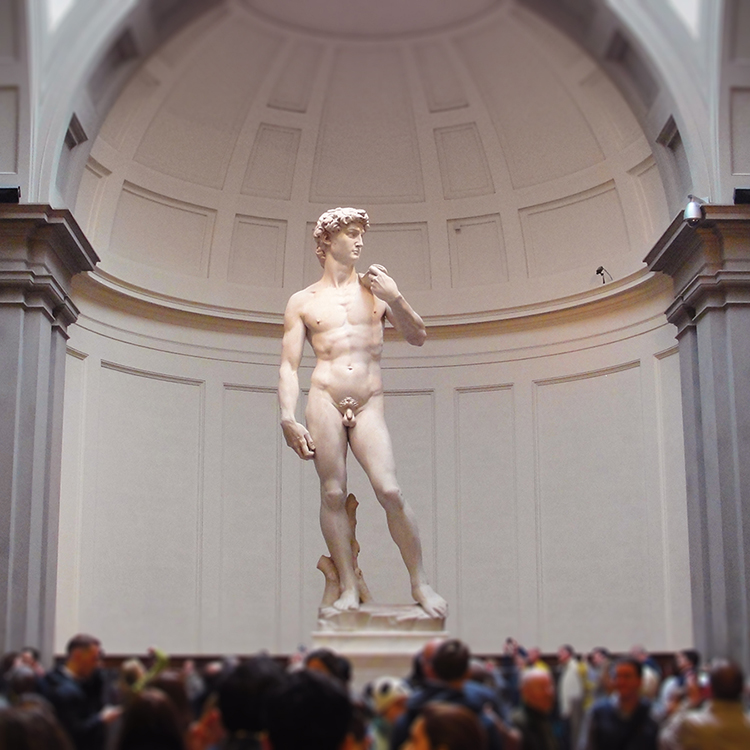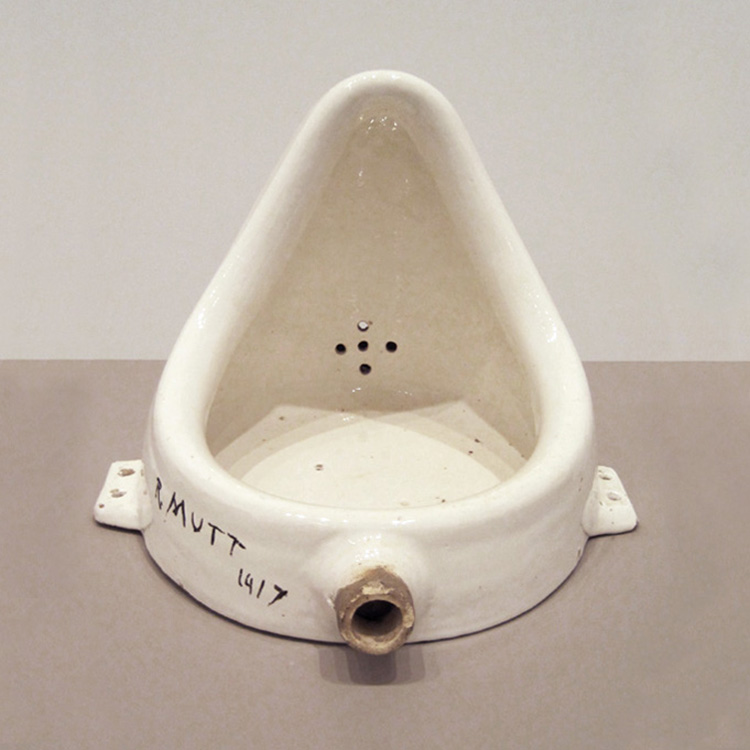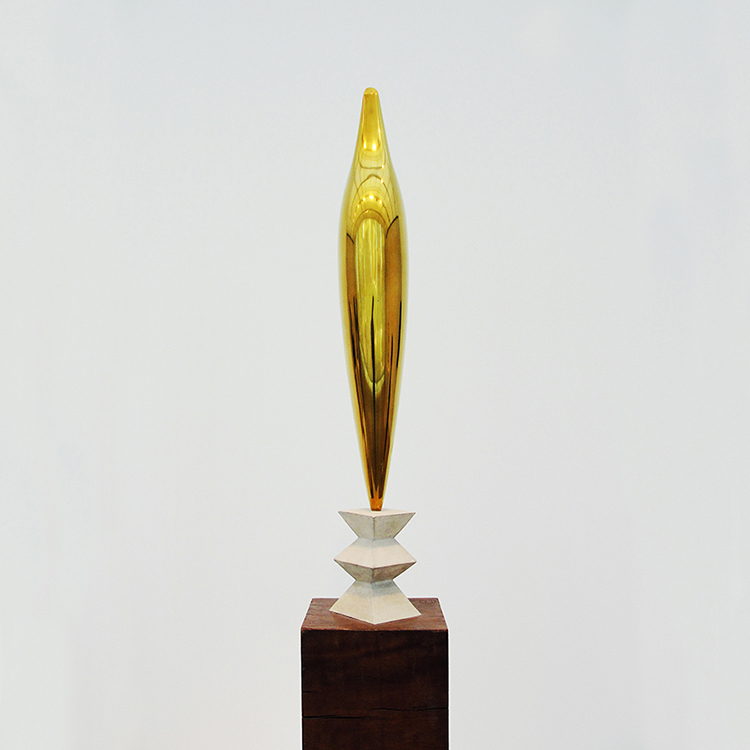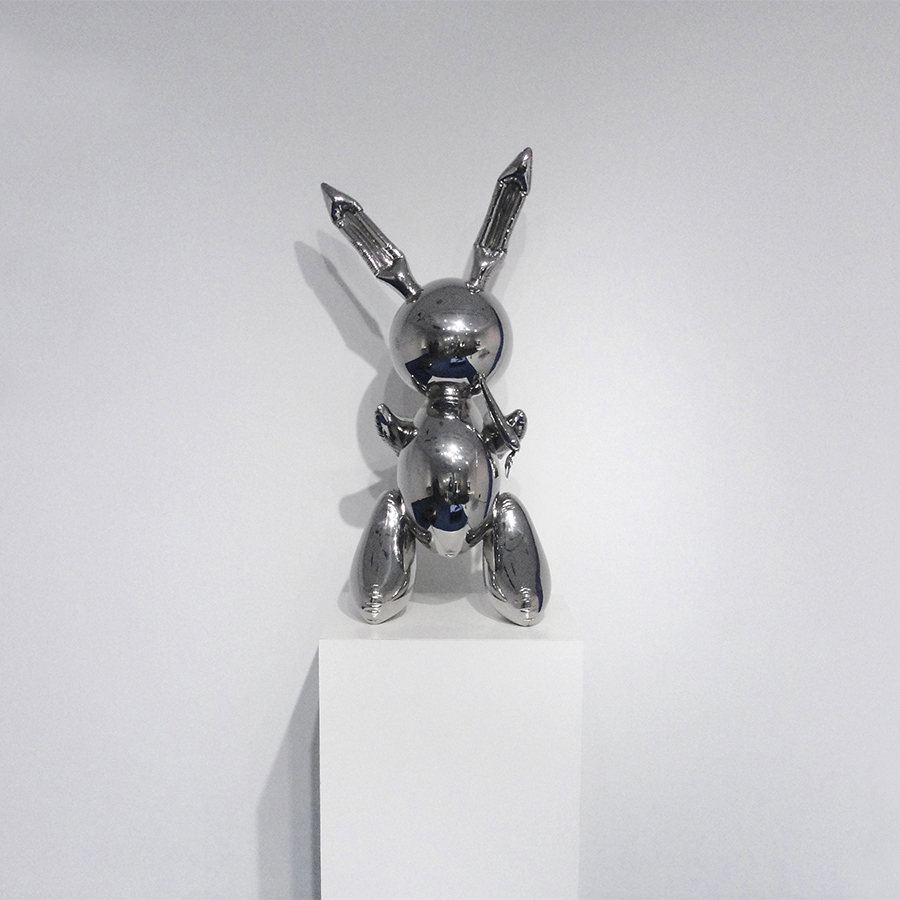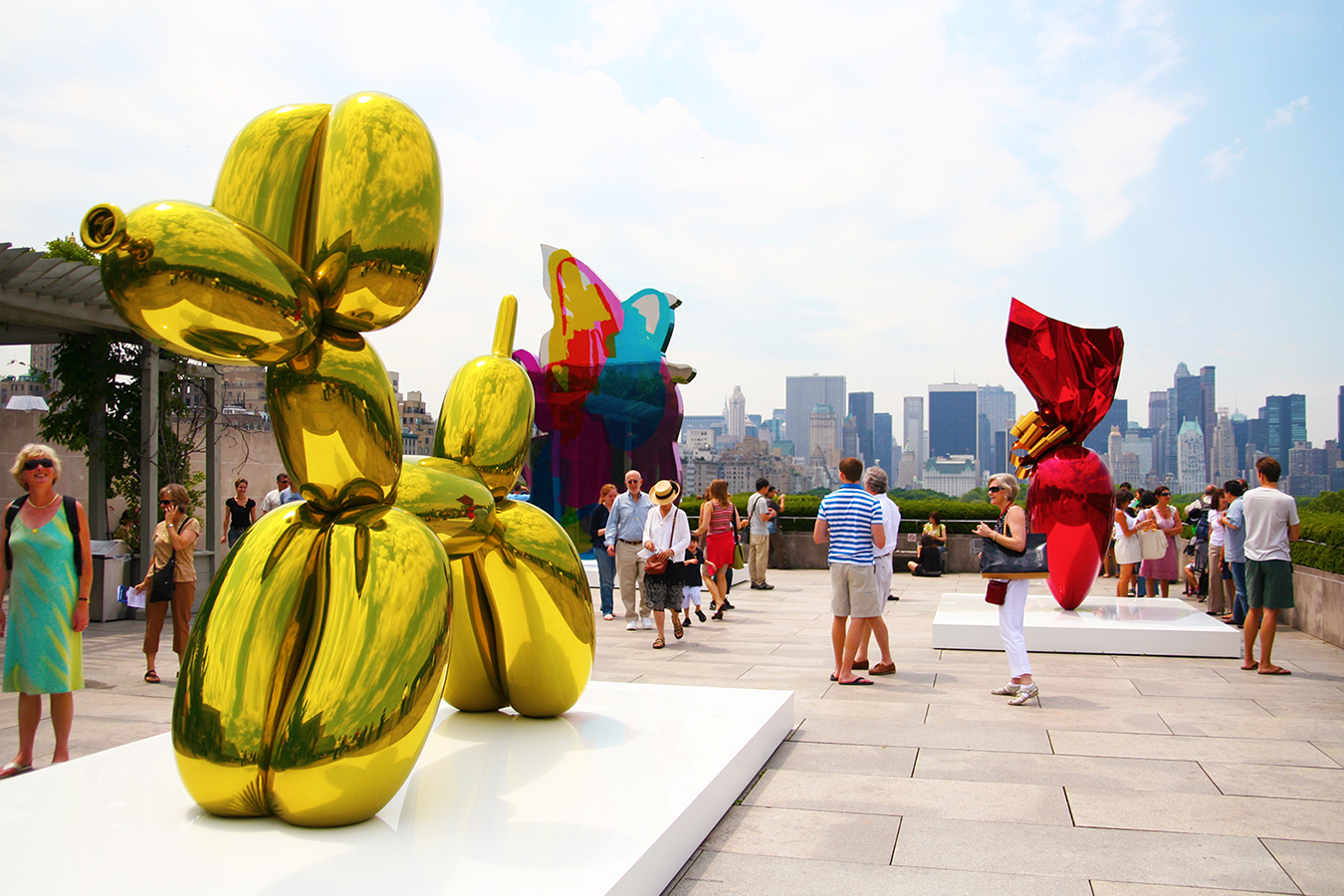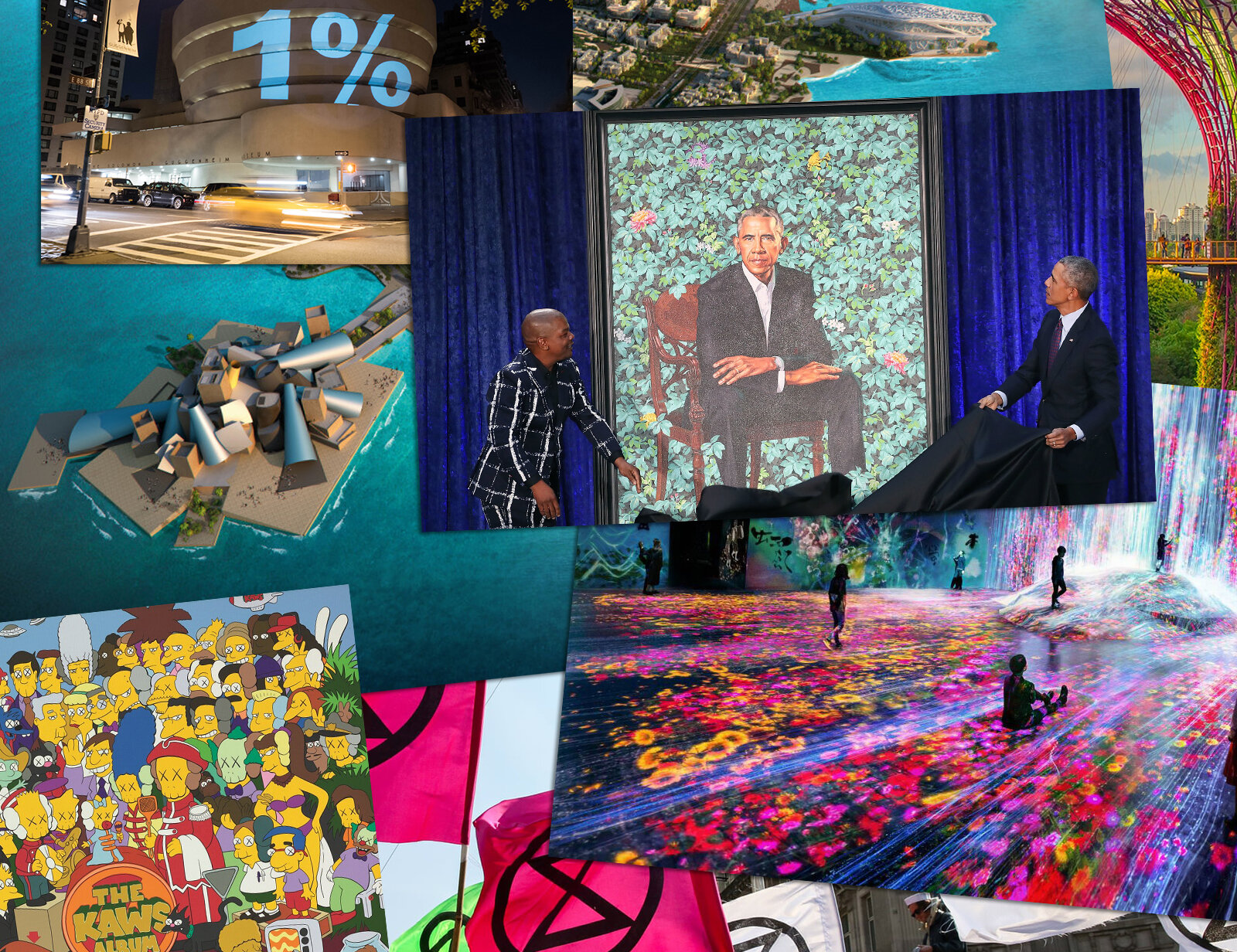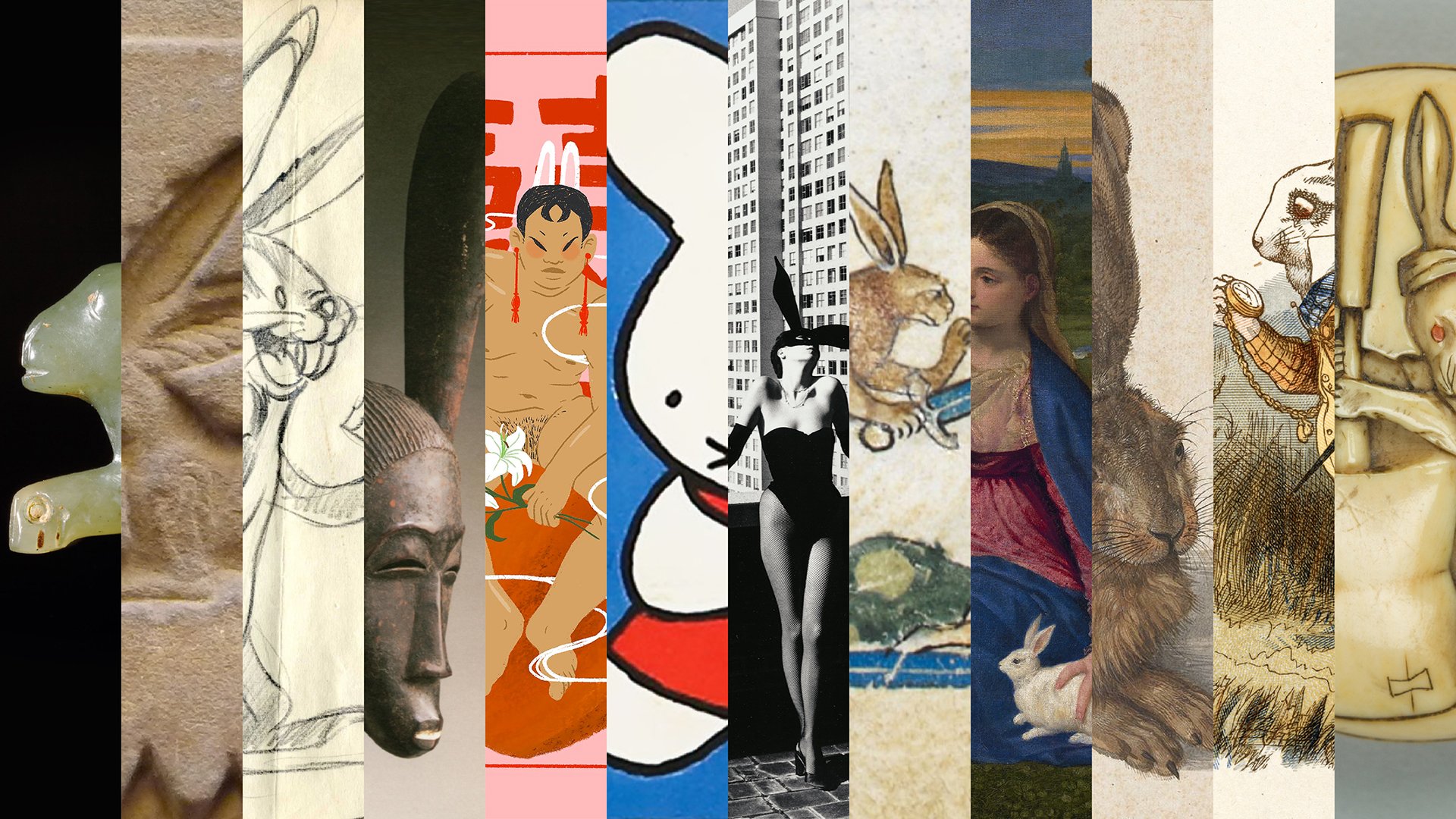Who is Record Breaking Jeff Koons?
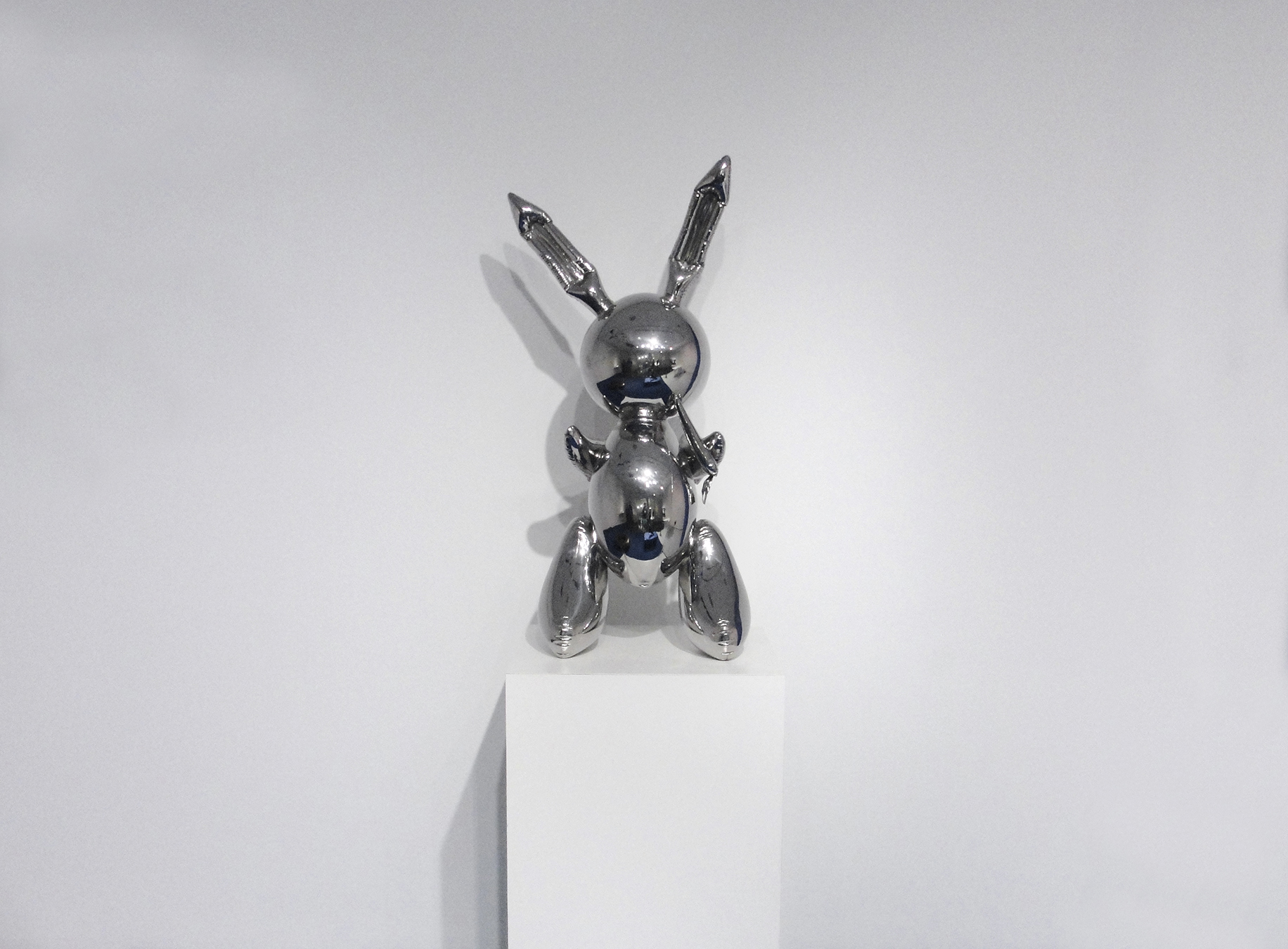
Koons just became the most expensive living artist once again. Rabbit sold Wednesday for a whopping $91 million. What is it and who is he?
Cover photo: Rabbit, stainless steel, by Jeff Koons, 1986, Museum of Contemporary Art Chicago, Chicago, Illinois, USA (2018).
Record-Breaking
Jeff Koons, 64 years old, just became the most expensive living artist once again. His 1986 Rabbit sold Wednesday for a total $91 million, narrowly beating David Hockney’s 1972 painting, Portrait of an Artist (Pool with Two Figures), which sold for $90.3 million in November of last year. The hammer price for both works is actually $80 million, but Christi’s Auction House increased buyer fees February 1st.
Koons previously held the record in 2013, with the auction of Balloon Dog (Orange) for $58.4 million. Rabbit had been estimated to sell between $50 and $70 million; the sculpture was purchased by New York art dealer Bob Mnuchin, the father of U.S. Treasury Secretary Steve Mnuchin, on behalf of a client. The American ultra-rich are clearly enjoying their tax-breaks.
Rabbit
Made of polished stainless steel, Jeff Koons’ faceless Rabbit is alien, beautiful, and mesmerizing. The 1986 sculpture stands just over 3 feet tall, surreal but cute. Rabbit is the perfect culmination of Marcel Duchamp’s irony and Constantin Brâncuși’s grace. The sculpture is a replica of a vinyl balloon Koons had used in a previous work, Inflatable Flower and Bunny (Tall White and Pink Bunny). Three editions of Rabbit exist, in addition to an artist’s proof.
Koons’ art career began in the late 70s. He was working at MOMA at the time and balloons and mirrors were among his favorite subjects. In 1979 Koons paired an inflatable vinyl flower and bunny he had found with a set of mirrors. This would serve as the genesis for Rabbit, in which Koons combines the form of the balloon with the reflective quality of the mirror. “He's taken stainless steel — originally recognized as a modest material — and elevated it to the height of luxury,” commends curator Scott Rothkopf.
The permanent integrity of stainless steel pairs well with the suggested fragility of the balloon. Koons describes his fascination with inflatables this way: “If you think about it, we’re like inflatables. We take a breath and we expand. We exhale, which is like a symbol of death: We deflate.”
The viewer’s reflection in Koons’ artwork “affirms that your participation is necessary.” Movement seems to awaken the Rabbit. He explains, “It’s not about the object, and it’s not about the image; it’s about the viewer. That’s where the art happens. The objects are absolutely valueless. But what happens inside the viewer—that’s where the value is.” Koons adds, “If I look at a Warhol soup can or a urinal by Duchamp, these are cries of communication. I don’t think they’re about the objects.” He pushes this idea to grandiose — and quasi-religious — limits, concluding, “I want people to be able to have a greater sense of their own potential through interacting with my work.”
The rabbit as an icon is loaded with cultural connotations: Bugs Bunny, Thorton Burgess’ Peter Cottontail, the White Rabbit from Lewis Carroll’s Alice in Wonderland, Playboy, Easter... The sculpture’s power lies in the juxtapositions of the work: Rabbit is American and global, real and surreal, sexual and innocent. You can project whatever you want onto the anonymous gleaming surface.
Rabbit has become Koons’ most recognized motif. It was included in the annual Macy’s Thanksgiving Day Parade in 2007 and was heavily featured in his collection with Louis Vuitton a decade later.
Alex Rotter, Chairman of Post-War and Contemporary Art at Christie’s Auction House, declares Koons’ Rabbit to be “one of the most important sculptures of the second half of the 20th century.” Rotter considers the work as the perfect antithesis to Michelangelo’s David, and a natural progression in the lineage of sculpture, for which “The end is a small bunny.”
The statement rings true — what could be further from the imposing marble masterpiece than a small metal rabbit — but is essentially meaningless hype by the auction house employee. Where does sculpture have left to go? Perhaps Rotter is unfamiliar with assemblage artist Isa Genzken, the golden ceramics of Yee Sookyung, or the textural forms of Sheila Hicks.
I don't mean to understate the beauty of Rabbit. It is a gorgeous work whose appeal will endure but it is certainly not the ultimate conclusion of sculpture. Nor is it possible to conceive its enormous price-tag. $91 million is a grotesque sum of money. Of course, artists don’t earn money from private sales but Koons will surely adjust the prices of his newest artworks accordingly.
Evan Beard, national art services executive at Bank of America Private Bank, explains, “Koons understands wealth and makes objects for the wealthy, who are in need of expensive investments and trophies. Like a prize at a carnival, someone won a bunny-shaped balloon. It will likely sell for more next time. Something will; the market remains hungry—for art and spectacle in equal measure.”
Koons has yet to respond to the news of the sale. On April First (April Fools), Hakim Bishara, author at Hyperallergic, falsely reported that Koons was retiring from art due to a religious epiphany. Amid the confusion, Koons proclaimed that nothing could be further from the truth: “I’m more engaged with my work than ever.”
King of Kitsch
So who is Jeff Koons? Well, I think of Koons as the plastic pink flamingo of the art world, a uniquely garish American whose works have become a symbol of wealth and culture. His art is filled with luxury, lust, and salesmanship. Koons’ work has been called sterile, artificial, stale, crass, and irreverent. Koons appears to be an artist of and for Wall Street. He is a polarizing figure; critics in the art world love him or hate him.
Jeff Koons rose to prominence in New York during the 80s. While his contemporaries were making work dedicated to socio-political struggles inspired by AIDS or women’s rights, Koons was making esoteric nonsense, like perfectly preserved vacuum cleaners or basketballs suspended in fishtanks. Some art critics lauded Koons as an artist elevating the mundane; others viewed this as vapid pretentiousness.
Blissfully unaffected, Koons continued to pursue American ideals in his 1988 Banality series under the guise of both parody and homage. Many of the sculptures were based on popular collector’s items and cartoonish antique figurines draped in nostalgia and bad taste. He created a porcelain rendition of Michael Jackson and Bubbles which he compared to pietàs from the Renaissance. In another work, the iconic Pink Panther is draped over a shirtless blonde Hollywood star.
In 1991, Koons created his Made in Heaven series of exhibitionist erotic artworks featuring himself and Italian porn star and politician Ilona Staller (La Cicciolina) whom he later married. Many critics decried the series as narcissistic homemade pornography. The two produced a child, then divorced, and a complicated legal battle ensued. This led Koons to co-found the International Centre for Missing & Exploited Children. Koons’ most popular series Celebration came afterwards, featuring his beloved Balloon Dogs. The project nearly bankrupted dealer Jeffrey Deitch, who had funded the monumental works.
Jeff Koons has embraced Warhol’s Factory model, employing upwards of a hundred painters, modelers, and craftsmen who deliver his concepts. Koons’ work has exhibited globally and he has collaborated with Lady Gaga, H&M, and Louis Vuitton. It’s difficult to determine if Koons’ work is a critique or a celebration of advertising, consumerism, and pop culture.
Origins
Jeff Koons was born in York, Pennsylvania, on January 21st, 1955. His mother was a seamstress and his father was a furniture dealer and decorator. From him, Koons would learn how an environment can manipulate emotions. At age eight, Koons painted and signed copies of Old Master paintings (a tactic he would revisit in his Gazing Ball series). His father would display the works in the shop window to attract business.
In fact, some of Koons’ earliest memories are those of sales. Of his childhood, he recalls, “I would go door-to-door, selling gift-wrapping paper, candies, chocolates — and I always enjoyed that I never knew who would open the door. It’s the same interaction that happens as an artist, wanting this communication.”
Koons studied at the School of the Art Institute in Chicago and graduated from the Maryland Institute of Art. He moved to New York City in 1976. He sold memberships at the Museum of Modern Art while making his own works and later became a broker on Wall Street to sustain his passion (he was the highest-performing salesperson on his team for two months in a row). His favorite recommendation was cotton commodities; he would artfully pitch to clients, “Cotton is light…it’s fluffy…you can’t get hurt by cotton.”
Koons’ days at his father’s store, his grandiose habit of copying, his time at the MOMA, his salesmanship, and his unabashed love of money: all this would serve him well in his art career.
Readymade Fabrication
Jeff Koons works in the lineage of Marcel Duchamp and Andy Warhol. He takes Duchamp’s concept of the infamous urinal readymade and multiplies it by the industrial standards of the famous Factory, where Warhol reproduced pop icon after pop icon (like Marilyn Monroe or Campbell’s Soup). Curator Donna De Salvo jokes, “If Warhol ever had a son, it would have been Jeff Koons.”
The Whitney Museum of American Art describes Koons this way: “Throughout his career, he has pioneered new approaches to the readymade, tested the boundaries between advanced art and mass culture, challenged the limits of industrial fabrication, and transformed the relationship of artists to the cult of celebrity and the global market.”
“When I started off as a young artist, at a certain point, Marcel Duchamp was everything to me. And I thought everything was based on Marcel,” Koons once explained. He has taken Duchamp’s example to the extreme, as many of his creations are shameless reproductions of other people’s art. His constant appropriation is not without consequence. Koons’ 1980s Banality series spurred five lawsuits. Most of which he settled or lost.
Koons’ work pushes the boundaries of authorship. His enormous studio, filled with employees, is not unique — the contemporary Japanese artist Takashi Murakami comes to mind — but Koons is particularly removed from the process. He doesn’t touch the artwork at all, but he insists it is made according to his specifications. When you consider the fact that Jeff Koons is making millions of dollars by employing other artisans to copy other people’s work, it’s difficult not to call him a con-artist.
Money
Jeff Koons’ primary role seems to be that of salesman. Yes, Koons markets his work to the wealthy though that alone doesn’t invalidate his art. Curator Norman Rosenthal notes, “that’s always been the case. Rubens had his kings and Bernini had his cardinals. [Koons is] supported by the cardinals and kings of his time.”
The allure of money does appear to color his perspective. Koons has co-designed a mega-yacht and collaborated with vintage champagne brand Dom Pérignon. “His trajectory since [the 80s], has gone with the money, management and product placement. It’s so calculated, so pre-pitched, so almost pre-sold, pre-placed that it lacks all the give and the breath of fresh art,” argues art critic William Feaver.
Technique
According to Koons, the large sums of money are just a means for creating his work. Regardless of whatever opinion I may have of him, I must admit Koons has pushed the technical limits of art. His stainless steel Balloon Venus, 2008-12, was created with the help of a CT scan — used for precise medical imaging — to capture every minute fold of the original balloon. Koons’ work Play-Doh was twenty years in the making, first conceived in 1994 but finally realized in 2014, in cast aluminum, to achieve all of its detail. And a 1996 exhibition at Guggenheim never came to fruition because “finding the technology to match Jeff’s vision became impossible,” admits former director Lisa Dennison.
Luxury
“To me art is not a luxury,” Koons has said. “If you acquire work, and I acquire works, I collect works, [sic] it’s really taking on a responsibility to try to preserve that work for future generations. I believe in it as a vessel of information that’s relevant to us as human beings.” Peter Brant, an art collector who bought Puppy — a behemoth 40 foot West Highland terrier carpeted in a bedding of plants — spends $75,000 a year for maintenance of the flora sculpture.
Controversy
In 2011, Jeff Koons attempted to sue Park Life, a San Francisco boutique that was selling balloon dog bookends remarkably similar to his creations. Park Life’s lawyer argued, “As virtually any clown can attest, no one owns the idea of making a balloon dog, and the shape created by twisting a balloon into a dog-like form is part of the public domain.” Koons was lambasted by much of the art world. How can someone who has made a career of appropriating found images and everyday icons dare to copyright something as ubiquitous as a balloon dog?
Koons caused further uproar in 2016 when he offered the city of Paris Bouquet of Tulips — a monumental hand holding eleven balloon flowers inspired by the Statue of Liberty — to commemorate recent terrorist attacks, to be placed in front of the Palais de Tokyo. Koons only donated the concept, with the production and installation to be funded by donations.
A group of French artists, politicians, and cultural figures published a letter in a local newspaper calling the proposed sculpture opportunistic, hideous, and culturally detached. Nevertheless, a deal has been struck for the sculpture to be placed in the lawn of the Petit Palais, near the Champs Élysées. Bouquet of Tulips is expected to be installed sometime this year.
Influence
There is no doubt Koons is among — perhaps the — most influential artists of our time. Love or hate him, but his works are sure to inspire lust, anger, awe, and scorn for the rest of his career. Congratulations Koons on reclaiming the throne of world’s most expensive living artist!
P.S. Questions!?
What do you think of Jeff Koons? Are his works filled with meaning? Or are they hollow? Is Koons making art for the ultra-wealthy? Or is it art for the common man? Are his works monuments to ironic anti-consumerism or luxurious indulgence?

